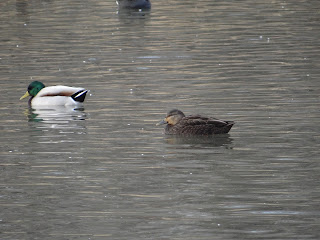Starting on January 1, 2017 my goal was to spend the year getting better at birding. I wanted to dive in and learn as much as possible. Only problem was that I knew just enough to identify the most basic, common birds. Here's an idea of how little I knew: I had just learned that you could only see Painted Buntings in the spring and summer. I had spent tons of time in the winter searching for them. My year list for 2016 was roughly 120, and a lot of those were found by other people who helped me look at them.
Overall, the year was a raging success. I went from an enthusiastic new birder to falling in love with birding, and I am stunned at how much I learned. I learned bird calls, how to look in habitats for different birds, and many other valuable things that I can't list for fear of rambling. The most important thing I learned was how easy it was to travel. I visited many places that I never thought possible, and I even redefined what I thought a long trip was. My goal was also to travel overnight to once place. After trips to Aransas, Big Bend, and two trips to the RGV I think I reached my goal! I'll give a run down of the year and maybe preview 2018 if I can keep this short enough!
Goal: 200 birds
Number of species seen: 272!
States/Countries: Texas (268), California (2), New York (1), Mexico (1)
Chases: American Black Duck (White Rock Lake, Success), Black Phoebe (Brazos Center, Success), Golden-crowned Sparrow (Warbler Woods, Success), Red-throated Loon (White Rock Lake, no luck), Tamaulipas Crow (Brownsville Landfill, no luck), Painted Redstart (Goliad State Park, Success)
 |
| Yellow-crowned Night Heron at Estero Llano Grande State Park |
Rarest Bird: American Black Duck was the rarest in Texas, but the White-collared Seedeater and Clay-colored Thrush were the rarest ABA birds and both were code 3s.
Favorite sightings: Painted Redstart, White-collared Seedeater, Lucifer Hummingbird
Favorite trip: Big Bend National Park
Biggest missed bird: Colima Warbler, Red-throated Loon, Tundra and Trumpeter Swan
Nemesis Birds: American Oystercatcher, Barred Owl, American Goldfinch
 |
| Golden-crowned Sparrow at Warbler Woods |
 |
| Sharp-shinned Hawk in Dallas |
 |
| A terrible picture given the rainy weather at sundown, but the last year bird was a Painted Redstart at Goliad State Park |
A few notes on the year: 200th bird was a Canyon Wren on the Lost Mine Trail at Big Bend on 7/2/17, so it took me only 6 months to hit the initial goal. Hit 250 in August with Clay-colored Thrush at Estero Llano Grande State Park. The job hunt and Aggie football slowed me down a ton in the fall and I only got 22 more before December 31. Bad weather in November and December killed birding at Anahuac and the Valley. Birds out of state were picked up on a road trip to A&M-UCLA without binoculars, which were California Towhee and Nuttall's Woodpecker, on a job interview in New York got me a Great Black-backed Gull in Central Park, and a Peregrine Falcon just across the Rio Grande in Mexico in Big Bend. While I hit 272 I missed out on many, many birds. Not being able to tell the difference between Common and Chihuahuan Raven is an example of a species I probably saw but was just not experienced enough to ID.
Locations birded: White Rock Lake (Dallas), Trinity River Audubon Center (Dallas), Lewisville Lake Environmental Learning Area (Lewisville), Hagerman National Wildlife Refuge (Grayson), Mackenzie Park (Lubbock), Lubbock Lake (Lubbock), Big Bend National Park (Brewster County, Texas), Commons Ford Park (Austin), Emma Long Park (Austin), Warbler Woods (Cibolo, Texas), Falcon State Park (Roma, Texas), Salineno (Salineno, Texas), Bentsen-Rio Grande Valley State Park (Misson, TX), Santa Ana National Wildlife Refuge (Alamo, TX), Estero Llano Grande State Park (Weslaco, TX), Laguna Atascosa National Wildlife Refuge (Los Fresnos, TX), South Padre Island Birding and Nature Center (South Padre Island, TX), Packery Channel Park (Mustang Island, TX), Quintana Neotropical Bird Sanctuary (Quintana, TX), Lafitte's Cove (Galveston, TX), Anahuac National Wildlife Refuge (Chambers County, TX), Attwater Prairie Chicken National Wildlife Refuge (Eagle Lake, TX), Brison Park (College Station), Lick Creek Park (College Station), Horizon Turf Farms (Burleson County, TX), Brazos Center (Bryan), WG Jones State Forest (The Woodlands, TX), Aransas NWR (Austwell, TX), Onassis Reservoir at Central Park (New York City), Griffith Observatory (Los Angeles)
























